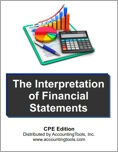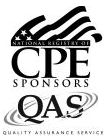The Interpretation of Financial Statements (CPE Course)
CPE Credit: 11 hours
Course Type: Downloaded PDF materials with online test
Price (with PDF Textbook): $75
Course Description
Financial statements are designed to show the performance, financial condition, and cash flows of a business. The Interpretation of Financial Statements course reveals how to convert these statements into an open book that can be explored in depth, giving crucial insights to investors, lenders, and creditors. The course does so by describing the structure of the financial statements, noting a number of tools for extracting information from the statements, and providing a wealth of additional insights into the reasons for the presence of or changes in certain numbers within the statements. In short, this course contains the complete set of tools for breaking down and examining a set of financial statements.
Author: Steven Bragg
Course Number: FN1018
Table of Contents
Chapter 1. Overview of the Financial Statements
Chapter 2. Interpretation of Cash and Investments
Chapter 3. Interpretation of Receivables
Chapter 4. Interpretation of Inventory
Chapter 5. Interpretation of Fixed Assets
Chapter 6. Interpretation of Other Assets
Chapter 7. Interpretation of Current Liabilities
Chapter 8. Interpretation of Debt
Chapter 9. Interpretation of Equity
Chapter 10. Interpretation of Sales
Chapter 11. Interpretation of the Cost of Sales and Gross Margin
Chapter 12. Interpretation of Operating Expenses
Chapter 13. Interpretation of Other Income, Taxes, and Profits
Chapter 14. Interpretation of Cash Flows
Chapter 15. Other Analysis Topics
Chapter 16. Additional Public Company Information
Learning Objectives
Recognize the accrual basis of accounting concept and how it functions, as well as the accounting equation concept.
Specify the business situations indicated by different cash levels and cash designations.
Cite the uses of the contribution margin and days sales outstanding measurements, as well as the situations in which they can be misleading.
Specify the industry situations in which an investment in inventory is considered to be more or less critical, as well as the reasons for different inventory turnover levels.
Cite the calculations used for the different depreciation methods, and the effects on profitability of the various depreciation rules.
State the contents of the prepaid expenses line item, as well as the situations that can change this balance. Also note the circumstances under which goodwill is considered to be impaired.
Identify the business conditions that can alter the balances in the current liabilities line items.
Identify the circumstances causing a change in debt classification, as well as the situations in which the debt level can be considered minor.
Specify the effects of debt-to-equity conversions on measurements, as well as the contents of the book value and tangible book value measurements.
Recognize the situations causing reliable sales, as well as the types of investors attracted to rapid sales growth.
Identify the contents of the cost of goods sold, and the methods used to improve the gross margin percentage.
Define the contents of operating expenses, and the business situations that can cause these line items to change.
Recognize the situations in which net operating losses may be generated, and the techniques used to improve the net profit margin and earnings per share.
Specify the contents of the different classifications within the statement of cash flows.
Identify the types of audit examinations, the uses to which the margin of safety can be put, and the contents of the dividend analysis formulas.
Specify the required contents of the different sections of the Form 10-K.
Level: Overview
Instructional Method: QAS Self-Study
NASBA Category: Finance
Prerequisites: None
Advance Preparation: None
Latest Review Date: February 2024
Program Registration Requirements: Click on "Purchase Course" near the top of this page to pay for and access the course. You will then be able to download the course as a PDF file, then take an on-line examination, and then download a certificate of completion if you pass the examination.
Program Refund Policy: For more information regarding administrative policies concerning complaints, refunds, and other matters, see our policies page.
AccountingTools, Inc. is registered with the National Association of State Boards of Accountancy (NASBA) as a sponsor of continuing professional education on the National Registry of CPE Sponsors. State boards of accountancy have the final authority on the acceptance of individual courses for CPE credit. Complaints regarding registered sponsors may be submitted to the National Registry of CPE Sponsors through its website: www.nasbaregistry.org.
The NASBA sponsor identification number for Accountingtools, Inc. is 115881.
AccountingTools is an IRS Approved Continuing Education Provider. We are compliant with the requirements for continuing education providers (as described in sections 10.6 and 10.9 of the Department of Treasury’s Circular No. 230 and in other IRS guidance, forms, and instructions). Our IRS Approved Continuing Education Provider number is 72821.


